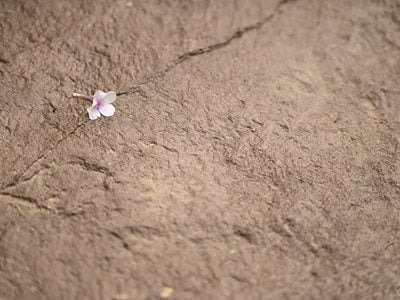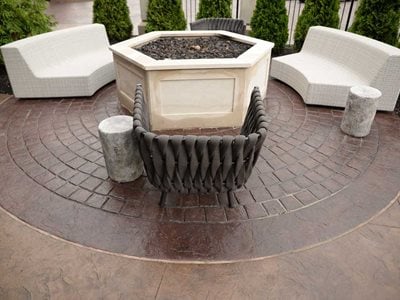
Stamp textures can be divided into several categories based on the pattern type. Each pattern type mimics a traditional paving material. The types of stamped concrete are generally divided into stone, brick, tile, slate, and wood textures. Picking the texture type is the first step when planning a textured concrete project. From there, the texture will guide color selection. For example, stone textures will most likely work best with grays and browns whereas a brick texture will almost always be red.
The two primary ways to color stamp concrete are integral color and color hardener. Integral color is pigment mixed into the concrete before it is poured. This creates consistent color throughout the concrete and requires little additional labor. Color hardener, also called dry shake hardener, is applied and finished into the surface of concrete. This requires more labor, but creates a wider range of colors with less material cost. Secondary colors are achieved using powdered release agents, stains, and other similar products. These add depth, create realism, and otherwise enhance the visual impact of the texture.

This is the simplest form of textured concrete. By using a single stamp pattern, contractors save labor and materials. Only one set of textures is needed. Only one or two colors are needed to color stamp concrete. This simplicity makes a single texture design an economical option. Small upgrades can be included with the addition of stains and secondary colors. Staining individual bricks or stones with water-based stains creates more natural and varied appearance without significantly increasing material cost or labor requirements. Color hardener can also be used to create streaks of secondary color and mottling. Creative stamped concrete coloring can easily upgrade these single texture projects.

A multi-textured slab is a higher tier of stamped colored concrete. This requires greater design skill, multiple sets of tools, and more materials. All of this work, however, results in a more varied and interesting product. The kind of installation is often found on high end stamped concrete patios and other luxury spaces. Multi-texture installations are also good for distinguishing different areas within the same property. For example, a fire pit may have one texture surrounding it while the nearby pool will have another.
The first step is to select the textures. Each texture should be complimentary or work within the same theme. If the project is small, it can likely be completed in the same pour. This is especially true if both textures are using the same color. The easiest texture combinations include texture skins. The feathered edge and non-patterned texture allows them to seamlessly blend with other stamps. Larger jobs or those using multiple integral colors will need to be completed using multiple pours. Plan accordingly to minimize unwanted visual disruptions in the patterns.
Borders are a common choice for stamped concrete driveways and walkways. This makes it possible to maintain a smooth surface for traffic but accent the installation with texture. This can be completed in multiple stages or at once, depending on the size of the project, design considerations, and installation preferences. Specialized border stamps are available, but regular stamps and textures will also work in this application. The non-stamped portion can be smooth troweled. For slip resistance, this portion is often given a broom finish or a light exposure using a retarder like Surface Deactivator.
Stamped, colored concrete can be used almost anywhere concrete pavement is placed. As such, there is nearly unlimited opportunity for small decorative flourishes on concrete projects large and small. With the use of color hardeners, stains, and coloring products such as Cem-Coat, a significant investment need not be made to create a pop of color.
Explore impressive concrete installations to find inspiration for your next project.
Find out how much color and fiber you'll need for any size project.